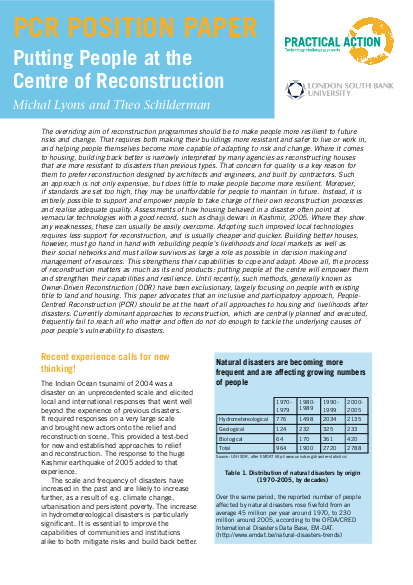
The overriding aim of reconstruction programmes should be to make people more resilient to future risks and change. That requires both making their buildings more resistant and safer to live or work in, and helping people themselves become more capable of adapting to risk and change. Where it comes to housing, building back better is narrowly interpreted by many agencies as reconstructing houses that are more resistant to disasters than previous types. That concern for quality is a key reason for them to prefer reconstruction designed by architects and engineers, and built by contractors. Such an approach is not only expensive, but does little to make people become more resilient. Moreover, if standards are set too high, they may be unaffordable for people to maintain in future. Instead, it is entirely possible to support and empower people to take charge of their own reconstruction processes and realise adequate quality. Assessments of how housing behaved in a disaster often point at vernacular technologies with a good record, such as dhajji dewari in Kashmir, 2005. Where they show any weaknesses, these can usually be easily overcome. Adopting such improved local technologies requires less support for reconstruction, and is usually cheaper and quicker. Building better houses, however, must go hand in hand with rebuilding people’s livelihoods and local markets as well as their social networks and must allow survivors as large a role as possible in decision making and management of resources. This strengthens their capabilities to cope and adapt. Above all, the process of reconstruction matters as much as its end products: putting people at the centre will empower them and strengthen their capabilities and resilience. Until recently, such methods, generally known as Owner-Driven Reconstruction (ODR) have been exclusionary, largely focusing on people with existing title to land and housing. This paper advocates that an inclusive and participatory approach, People-Centred Reconstruction (PCR) should be at the heart of all approaches to housing and livelihoods after disasters. Currently dominant approaches to reconstruction, which are centrally planned and executed, frequently fail to reach all who matter and often do not do enough to tackle the underlying causes of poor people’s vulnerability to disasters.
Resource collections
- Accountability to affected populations (AAP)
- ALNAP focus topics
- UN Habitat - Urban Response Collection
- Urban Response - Urban Crisis Preparedness and Risk Reduction
- Urban Response Collection - Community Engagement and Social Cohesion
- Urban Response Collection - Economic Recovery
- Urban Response Collection - Environment and Climate Change
- Urban Response Collection - Housing, Land and Property
- Urban Response Collection - Urban Crisis Response, Recovery and Reconstruction
- Urban Response Collection - Urban Resilience